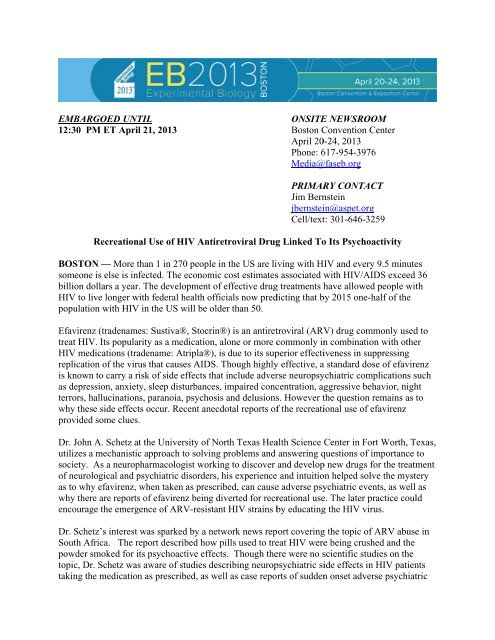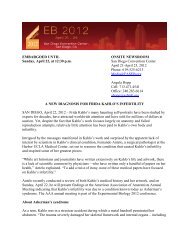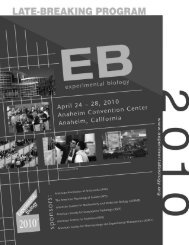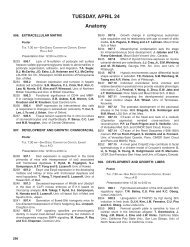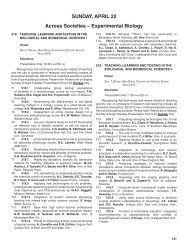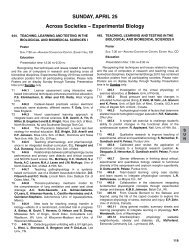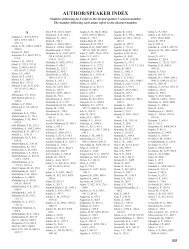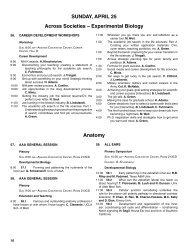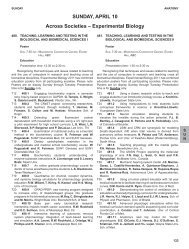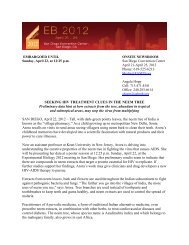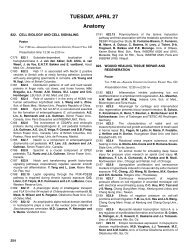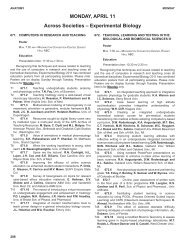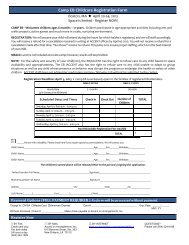Recreational Use of HIV Antiretroviral Drug Linked to its Psychoactivity
Recreational Use of HIV Antiretroviral Drug Linked to its Psychoactivity
Recreational Use of HIV Antiretroviral Drug Linked to its Psychoactivity
You also want an ePaper? Increase the reach of your titles
YUMPU automatically turns print PDFs into web optimized ePapers that Google loves.
EMBARGOED UNTIL12:30 PMET April21, 2013ONSITENEWSROOMBos<strong>to</strong>n Convention CenterApril 20-24, 2013Phone: 617-954-3976Media@ @faseb.orgPRIMARY CONTACTJim Bernsteinjbernstein@aspet.orgCell/text: 301-646-3259<strong>Recreational</strong> <strong>Use</strong> <strong>of</strong> <strong>HIV</strong> <strong>Antiretroviral</strong> <strong>Drug</strong>g <strong>Linked</strong> ToIts <strong>Psychoactivity</strong>BOSTON— More than 1 in 270people in the US are living with <strong>HIV</strong> and every9.5 minutessomeone is else is infected. The economic cost estimatess associated with <strong>HIV</strong>/AIDS exceed 36billion dollars a year. The development <strong>of</strong> effective drugg treatments have allowed people with<strong>HIV</strong> <strong>to</strong> live longer with federal health <strong>of</strong>ficials now predicting that by 2015 one-half <strong>of</strong> thepopulation with <strong>HIV</strong>in the US will be older than 50.Efavirenz(tradenames: Sustiva® ®, S<strong>to</strong>crin®) is an antiretroviral (ARV) drug commonly used<strong>to</strong>treat <strong>HIV</strong>. Its popularity as a medication, alone or more commonly incombination with other<strong>HIV</strong> medications (tradename: Atripla®), is due <strong>to</strong> <strong>its</strong> superior effectiveness in suppressingreplication <strong>of</strong> the virus that causes AIDS. Though highlyy effective, a standard dose <strong>of</strong> efavirenzis knownn <strong>to</strong> carry a risk <strong>of</strong> side effects that include adverse neuropsychiatric complications suchas depression, anxiety, sleep disturbances, impaired concentration, aggressive behavior, nightterrors, hallucinationns, paranoia, psychosis and delusions. However the question remains as <strong>to</strong>why these side effects occur. Recent anecdotal reports <strong>of</strong>f the recreational use <strong>of</strong> efavirenzprovidedd some clues.Dr. John A. Schetz atthe University <strong>of</strong> NorthTexas Health Science Center in Fort Worth, Texas,utilizes a mechanisticc approach <strong>to</strong> solving problems and answering questions <strong>of</strong> importance <strong>to</strong>society. As a neuropharmacologist working <strong>to</strong> discover and developnew drugs for the treatment<strong>of</strong> neurological and psychiatric disorders, hisexperience and intuition helped solve the mysteryas <strong>to</strong> whyefavirenz, when taken as prescribed, can causee adverse psychiatric events, as well aswhy there are reports<strong>of</strong> efavirenz being diverted for recreational use. The later practice couldencourage the emergence <strong>of</strong> ARV-resistant <strong>HIV</strong> strains by educatingthe <strong>HIV</strong> virus.Dr. Schetz’s interest was sparkedby a network news report coveringthe <strong>to</strong>pic <strong>of</strong>ARV abuseinSouth Africa. The report described how pills used <strong>to</strong> treat <strong>HIV</strong> weree being crushed and thepowder smoked for <strong>its</strong> psychoactive effects. Though there were no scientific studies on the<strong>to</strong>pic, Dr. Schetz wasaware <strong>of</strong> studies describing neuropsychiatric side effects in<strong>HIV</strong> patientstaking the medicationas prescribed, as well as case reports <strong>of</strong> suddenonset adverse psychiatric
events in patients with no his<strong>to</strong>ry <strong>of</strong> mental illness. However, research study results suggestedthat the later patient population were genetically predisposed because they have less effectivevariants <strong>of</strong> the enzyme primarily responsible for metabolizing efavirenz, leading <strong>to</strong> much slowerthan expected breakdown <strong>of</strong> efavirenz, and consequently higher than expected levels <strong>of</strong> drug inthe body. Dr. Schetz initiated his investigation with molecular pr<strong>of</strong>iling <strong>of</strong> the recep<strong>to</strong>rpharmacology <strong>of</strong> efavirenz which lead <strong>to</strong> the pinpointing <strong>of</strong> interactions with multipleestablished sites <strong>of</strong> action for other known drugs <strong>of</strong> abuse. He and a number <strong>of</strong> his colleaguesworked <strong>to</strong>gether <strong>to</strong> achieve a pre-clinical understanding <strong>of</strong> the psychoactivity induced byefavirenz that may help explain reports both <strong>of</strong> <strong>its</strong> adverse neuropsychiatric side effects in <strong>HIV</strong>patients and <strong>of</strong> <strong>its</strong> diversion for recreational use.Dr. Schetz’s work is the first ever study <strong>of</strong> the mechanisms <strong>of</strong> efavirenz’s psychopharmacologyand these new findings will help stimulate interest <strong>to</strong> support additional research related <strong>to</strong> themechanism <strong>of</strong> ARV side effects and abuse potential. This would help translate the pre-clinicalfindings in<strong>to</strong> preventative measures addressing <strong>HIV</strong> medication-induced adverse side effects inpatients living with <strong>HIV</strong>. Additionally, preventative strategies would improve patient adherenceand quality <strong>of</strong> life, reduce the potential risk for the emergence <strong>of</strong> <strong>HIV</strong> drug resistant strains, andcould prevent diversion <strong>of</strong> <strong>HIV</strong> medication for illicit use.”His findings will be presented April 21, 2012 during Experimental Biology 2013 in Bos<strong>to</strong>n, MA.To request an interview with Dr. Schetz, please contact Jim Bernstein at the contact informationlisted above.###About Experimental Biology 2013Experimental Biology’s mission is <strong>to</strong> share the newest scientific concepts and research findingsshaping future and current clinical advances – and <strong>to</strong> give scientists and clinicians anunparalleled opportunity <strong>to</strong> hear from colleagues working on similar biomedical problems usingdifferent disciplines. With six sponsoring societies and another 20 U.S. and international guestsocieties, the annual meeting brings <strong>to</strong>gether scientists from throughout the United States and theworld, representing dozens <strong>of</strong> scientific areas, from labora<strong>to</strong>ry <strong>to</strong> translational <strong>to</strong> clinicalresearch. The meeting also <strong>of</strong>fers a wide spectrum <strong>of</strong> pr<strong>of</strong>essional development sessions.About the American Society for Pharmacology and Experimental TherapeuticsASPET is a 5,100 member scientific society whose members conduct basic and clinicalpharmacological research within the academic, industrial and government sec<strong>to</strong>rs. Our membersdiscover and develop new medicines and therapeutic agents that fight existing and emergingdiseases, as well as increase our knowledge regarding how therapeutics affects humans.


